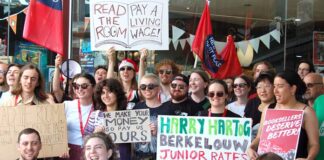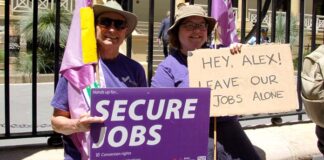Amy Thomas looks at the inspiring story of how workers beat back Joh Bjelke-Petersen
Imagine the joy of seeing a humiliated Queensland Premier Campbell Newman backing down from his anti-union laws on television. Thirty years ago, that is what the power of organised workers did to the notoriously anti-union and authoritarian National Party Premier, Joh Bjelke-Petersen.
In 1982, a massive, spontaneous, rank-and-file general strike, only the second in Queensland’s history, led to what The Battler (Solidarity’s predecessor publication) called at the time, “his biggest ever backdown”. If the strike had gone further, workers could have toppled him before the Fitzgerald Inquiry into corruption in the late 1980s put the final nail in the government’s coffin.
Bjelke-Petersen ruled with an iron fist from 1968 to 1987, but he was challenged from below from the start. During the 1971 tour of the all-white South African Springboks rugby team, Petersen declared a state of emergency to outlaw demonstrations. But thousands of anti-racist protesters defied him.
In 1977, Bjelke-Petersen announced his famous ban on the right to march. He declared street marches “a thing of the past.” For two years, the right to march campaign, linked with abortion, anti-uranium and land rights campaigns, brought thousands of workers and students onto the streets, to defy the law and face down the police to win back their democratic rights.
Workers’ power
But the one group in society that had the power to bring down Bjelke-Petersen was the working class. The power and electricity workers’ unions, bastions of rank-and-file activism, went head-to-head with him several times, and were not defeated until the SEQEB dispute of 1985.
A successful strike by Gladstone power workers in August 1978 angered Bjelke-Petersen, and within a year he had prepared the Essential Services Bill. The Bill gave the government sweeping powers. It could order an immediate return to work, sack anyone defying such an order for more than 48 hours, allow business to sue for damages, impose fines, de-register unions, and allow government to take control of industry. It also allowed them to ban the collection of strike funds.
Russel Hinze, the Minister for Local Government and Main Roads (who was later disgraced in the Fitzgerald Inquiry), drew up the bill. When asked about the possibility of a general strike in response, Hinze replied: “Let’s see how good the union leaders are!” But passing the bill was one thing for the government, using it, quite another. When power workers struck again, for 48 hours in 1980, Bjelke-Petersen retreated without using the bill and the workers notched up another victory.
The campaign for the 38-hour week brought the first confrontation with Bjelke-Petersen over the Essential Services Act. In 1982, the metal trades nationally gained the 38-hour week, sparking a national campaign for shorter hours.
The strike wave began when, according to The Battler, “the government withdrew a firm offer to introduce the 38 hour week.” Immediately, the railway workers announced a 48-hour strike from midnight on Sunday, August 15. The Australian Workers Union (AWU), not known for its militancy, called a stop work of its government employees.
By Monday, thousands of workers were on strike. Outraged, Bjelke-Petersen declared a state of emergency. He promised that union leaders would be “knocked down in the rush of men wanting to get back to work” because “anybody that turns up for work will have a job forever.” He threatened those who didn’t show up with suspension.
Building workers’ leader Hugh Hamilton announced, “The government has gone crazy … if anyone is sacked the industrial action will widen.” But the officials did not expect Bjelke-Petersen to live up to his word—and they had no intention of launching a militant campaign.
Mass meetings were held all over Queensland on the Monday morning. The union officials argued for a 24-hour stoppage instead of the 48 hours that union delegates were demanding. But they didn’t get their way.
They succeeded in winning over the Brisbane meeting, and most government workers in the capital returned to work on Tuesday. But in the regional meetings, the officials were overruled by workers willing to fight. Townsville, Mackay, Bundaberg and Maryborough meetings all voted to stay out for 48 hours. At an Ipswich meeting of railway workers, union leaders were abused for their timidity and a vote for 48 hours was won almost unanimously.
Bjelke-Petersen thought he could use the division to end the strike. That night, in a move “calculated to divide the strikes and isolate the militants”, according to The Battler, Petersen announced the suspension of 3500 railway workers. He gave the striking workers until 8pm that night to return to work. The next day, he even moved to de-register 11 unions.
Trades and Labour Council Secretary Fred Whitby declared that the government “must be smoking opium” to think it could get away with this attack. Bjelke-Petersen’s move provoked a strike wave that brought the government to its knees.
In Years of Rage, Tom O’Lincoln describes the breadth of the strike: “The railways stayed closed; car workers, oil workers and coal miners walked off the job; and the AWU decided to bring its members out, as did glass and metal unions. The maritime industry stopped dead. Most important of all were the massive power cuts which shut down basic industry, and were seen as symbolising the strength of the working class.”
The Battler reported, “Railway station officers in Central Queensland walked off the job and rang the union to say they were out until Bjelke-Petersen was beaten and most building sites stopped.”
Teachers joined the strike—their first in 80 years. Nurses from Wolston Park hospital marched through Ipswich streets, chanting, “One, two, three, four, we don’t want your fascist law” and “38 hours now! Bjelke-Petersen must go!”
“The atmosphere was electric. The government was under siege and the most fantastic unity was being built,” said The Battler. Shop stewards and delegates in Ipswich set up a food co-op to feed the strikers and their families. Workers toured the pubs collecting money. A spontaneous general strike had spread throughout Queensland.
According to The Courier-Mail, by Thursday the government was contemplating the fact “that its Essential Services Legislation was ineffectual, having been told that de-registration moves against unions, fines on unions and the right of private citizens to sue for loss caused by strikes were impossible to enforce.” Bjelke-Petersen even called a local Gladstone journalist to “check the union climate in the city” before visiting to open a new aluminium smelter.
On Friday night, Bjelke-Petersen capitulated on television. “It was a joy to watch,” said The Battler. “The haughty, arrogant, raving lunatic we usually put up with was gone. He was humiliated and wanted to get it over as soon as possible.” He lifted the suspensions, lifted the state of emergency, revoked all provisions of the Essential Services Act and stopped proceedings to de-register the unions. It was the biggest defeat of his Premiership.
Possibilities
However, Bjelke-Petersen did not back down on the 38 hour week itself.
Emboldened by the strike wave, over the weekend, the TLC decided to call a general strike in support of the 38- hour week. In the context of massive strikes that had shut down Queensland for the past week, it was also effectively a call to demand that Bjelke Petersen step down.
The government was on the defensive and further concessions could have been won. The spontaneous upheaval against the suspensions needed to be turned into a political fight against the government. But having called a general strike, the union officials did nothing to build it.
In a disastrous move, they sent the power workers back to work. Then, as other unions pulled out one by one, they summarily ended the strike on Tuesday afternoon without even a mass meeting. Without rank-and-file organisation in the unions to carry through the arguments to keep fighting, the general strike was over. Bjelke-Petersen survived the 1982 general strike to hang on to power for another five years.
Lessons
Nevertheless, there are lessons in Bjelke-Petersen’s defeat in 1982. Even the most rampant, power-hungry rulers can be humbled by collective union activity. And at every point, it was the courage, ingenuity and enthusiasm of the workers themselves, not their union leaders, that spurred the movement on and ensured Bjelke-Petersen’s backdown.
In Campbell Newman’s maiden speech to parliament he praised Bjelke-Petersen’s “many achievements”, and announced his intention to “live up to the standards of my eminent predecessors.” True to his word, Newman has quickly begun a relentless drive to attack unions and workers’ rights.
He has tried to tame unions by imposing more stringent ballots for strike action. He has used legislation similar to that introduced by the NSW Liberal government to limit wages rises and remove job security and other conditions from Enterprise Agreements.
Rather than a campaign to defy Newman’s laws, the Queensland Council of Unions and the public sector union Together, facing up to 20,000 public sector job cuts, has left the battle to the courts and to television advertisements designed to promote the re-election of a Labor government in years to come.
Newman’s cuts are hated and there is a willingness to fight. The 60-day illegal strike at the Brisbane Children’s Hospital Abigroup construction site, won despite numerous court orders, and shows how Newman’s arrogance can be turned into humiliation. But the fight against Newman, like the 1982 general strike, needs rank and file organisation, and the politics of defiance to be built from the bottom up.





